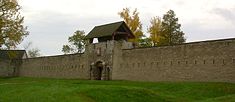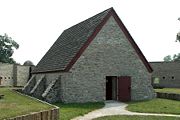Fort de Chartres
2008/9 Schools Wikipedia Selection. Related subjects: Architecture
| Fort de Chartres | |
|---|---|
| (U.S. National Historic Landmark) | |
|
|
|
| Nearest city: | Prairie du Rocher, Illinois |
| Built/Founded: | 1756 |
| Added to NRHP: | October 15, 1966 |
| NRHP Reference#: | 66000329 |
| Governing body: | State |
Fort de Chartres was a French fortification first built in 1720 on the east bank of the Mississippi River (in present-day Illinois). The Fort de Chartres name was also applied to the two successive fortifications built nearby during the 1700s in the era of French colonial control over Louisiana and the Illinois Country in North America.
A partial reconstruction of the third and last fort, which was built of local limestone shortly before the end of French rule in the Midwest, is preserved in an Illinois state park south of St. Louis, Missouri, four miles West of Prairie du Rocher in Randolph County, Illinois.
The original fort's name honored Louis, duc de Chartres, son of the Regent of France. The fort's stone armory, which survived the gradual ruin that overtook the rest of the site, is considered the oldest building in the state of Illinois. The state park today hosts several large re-enactments of colonial-era civil and military life each summer at the fort.
History
On January 1, 1718, a trade monopoly was granted to John Law and his Company of the West (which was to become the Company of the Indies in 1719). Hoping to make a fortune mining precious metals, the company built a fort to protect its interests. The original wooden fort was built in 1718- 1720 by a French contingent from New Orleans, led by Pierre Dugué de Boisbriand, when administration of the Illinois Country was moved from Canada to New Orleans. Governance was transferred to the Company of the Indies and the fort was built to be the seat of government and to control the Indians of the region, particularly the Fox. The original fort was a palisade of logs with two bastions at opposite corners.
Within five years, flooding from the Mississippi had left the original fort in bad condition. Construction of a second fort farther from the river, but still on the flood plain, began in 1725. This fort was also made of logs and had a bastion at each of the four corners. By 1731, the Company of the Indies had gone defunct and turned Louisiana and its government back to the king.
The second wooden fort deteriorated somewhat less rapidly, but by 1742 it was in bad repair. In 1747 the French garrison moved to the region's primary settlement 18 miles to the south at Kaskaskia, and the French debated where to rebuild the fort. Discussions of a stone fortress had begun in the 1730s, with the reverseion of rule back to the French crown. The government in New Orleans wanted to move the garrison permanently to Kaskaskia, but the local commandant argued for a location near the original.
The decision was eventually reached to build in stone near the first forts rather than at Kaskakia. Construction began in 1753 and was mostly completed in 1756, however, construction continued at the site for another four years. The limestone fort had walls 15 ft (3 m) high and 3 ft (1m) thick enclosing an area of 4 acres (16,000 m²). The stone for construction was quarried in bluffs about two or three miles (4 km) distant and had to be ferried across a small lake. In 1763 the Treaty of Paris was signed and the French transferred control of the Illinois Country to Great Britain. The stone fort had served as centre of French administration of the region for only ten years. Almost all of the land between the Appalachian Mountains and the Mississippi River from Florida to Newfoundland became a Native American territory called the Indian Reserve following the Royal Proclamation of 1763. The British had difficulty getting a regiment to their newly acquired fort, but on October 10, 1765, the 42nd Royal Highland Regiment took control of the fort and surrounding area. Settlers were ordered to leave or get a special license to remain. This was to cause many of the French settlers in the area to move to St. Louis. The fort was renamed Fort Cavendish. The British, however, saw little value in the fort and abandoned it in 1771.
Ruin and Reconstruction
The Mississippi continued to take its toll after the fort was abandoned, and in 1772 the south wall and bastion fell into the river. The remaining walls deteriorated, and visitors noted trees growing in them by the 1820s. Locals carted away the stone for construction bit by bit over the years, and by 1900 the walls were gone. The only part of the original fort that remained was the stone building that had served as the powder magazine.
The State of Illinois acquired the ruins in 1913 as a historic site and restored the powder magazine in 1917. The powder magazine is thought to be the oldest existing building in the state of Illinois. In the 1920s foundations of the fort's buildings and walls were exposed, and in the late 1920s and through 1930s the WPA rebuilt the gateway and two stone buildings. A combination museum and office building, built in 1928 on the foundation of an original fort building, houses exhibits depicting French life at Fort de Chartres. The large stone “Guards House,” built in 1936, contains a Catholic chapel furnished in the style of the 1750s, along with a priest’s room, a gunner’s room, an officer-of-the-day room, and a guard’s room. Also on the grounds are an operating bake oven, a garden shed built of upright logs in “post-on-sill” construction, and a kitchen garden with raised beds of produce that would have been grown in eighteenth-century Illinois.
Partial reconstruction of the fort's walls on the original foundations followed in 1989. The frames of some additional buildings were erected as a display of the post and beam construction techniques used on the originals. Other buildings' foundations and cellars were exposed for educational display as well.
Today the site has a museum and small gift shop. It plays host each June to a Rendezvous that is one of the largest and oldest in the country, celebrating frontier French and Indian culture. The site is protected by modern levees, but the Mississippi is still an occasional menace. In the flood of 1993 the levee was breached, and water fifteen feet deep lapped at the top of the walls.
Location
- Fort de Chartres is at coordinates Coordinates:


